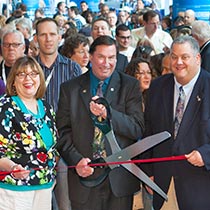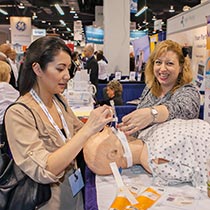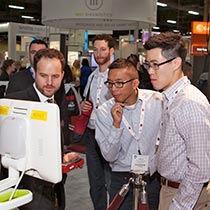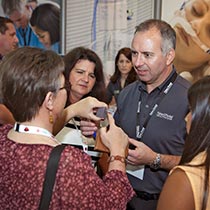Sunday Gazette
Welcome Party gives Congress-goers a chance to kick back and relax
Day 1 of the AARC Congress was packed with activities, and Congress-goers were definitely ready for a little R&R by the time the last session was over. They got that and more at the Welcome Party. With music by the Mars Hill band and complimentary drinks and snacks, it proved to be the perfect place to unwind and network with friends and colleagues from across the country and around the world.
President’s report
By Frank Salvatore, MBA, RRT, FAARC
It’s hard to believe that it has been 676 days since my installation as your president back in Las Vegas in December of 2014. This past almost two years has been full of activity and I want to thank all of those who’ve served on the AARC Board of Directors, AARC House of Delegates, and in the various committees of both bodies.
I also would be remiss if I didn’t thank the men and women of the AARC Executive Office who made my job as your president much easier. This profession continues to be served well by these groups.
The following is a review of the past year and highlights of how we’re doing based on my presidential goals:
- Continue to develop and execute strategies that will increase membership beyond 50,000 active members and participation in the AARC both nationally and internationally.
- Membership continues to be a primary goal and we’ve worked hard at finding ways to not only get new members but to retain them as well. I’m sure we will continue to advance towards that 50,000-member level.
- We continue to work diligently on getting students to move to active members on graduation, find ways to keep our elder statesman of the profession as members, and have taken great strides to bring members back who have let their membership lapse.
- Promote activities to increase public awareness of respiratory therapists and their role in the diagnosis and treatment of respiratory disorders.
- The AARC has served as a consultant to, and one of our members from California, Jeffrey Davis, participated as a interviewee for a tribute film titled “COPD: Highly Illogical — A Tribute to Leonard Nimoy.”
- The AARC worked with the Alliance for Patient Access to create a white paper that was issued by the Institute for Patient Access (IfPA). The paper outlines the need to improve access to respiratory care for patients with chronic lung conditions like COPD, asthma, and idiopathic pulmonary fibrosis.
- Advance the concepts and initiatives brought about by the “Respiratory Therapist for 2015 and Beyond” conferences. Develop a toolkit to ensure the existing educational programs are able to move in a direction that will allow them to continue to develop our future students at a level that is consistent with them obtaining a bachelor’s degree, which will eventually become the entry into our profession.
- We continue to work in partnership with other organizations to help programs that can move from an associate’s degree granting institution to a bachelor’s degree granting program. In 2016, we’ve begun work to look at the 88 institutions that reside in bachelor’s degree granting institutions to help them begin the process by offering to partner them with advisors/mentors that have completed the process in their own institution.
- With the update to the Respiratory Therapy Education Position Statement in November of 2015, we’ve seen CoARC update its standards and have attended their open comment period in the summer and will again in October here at the Congress to answer questions and support their accreditation standard changes.
- Promote and advocate for appropriate patient and caregiver access to respiratory therapists in all care settings through local, state and national legislation, regulation and/or policies including, but not limited to, recognizing respiratory therapists outside the traditional health care venues as well as recognizing the credential of Registered Respiratory Therapist (RRT) as the minimum requirement for licensure.
- We continue to advocate for HR 2948, the Medicare Telehealth Parity Act of 2015. This bill will positively impact respiratory therapists and the respiratory care profession and profoundly help Medicare pulmonary patients. We must work within the states to create a ground swell of support for this; we need to make a significant push for this bill to be passed in 2016!
- We continue to work with states that are working with their legislative bodies and regulatory agencies as they begin the process of making the RRT the entry credential for licensure.
- Continue to advance our international respiratory community presence through activities designed to address issues affecting educational, medical and professional trends in the global respiratory care community and to advance advocacy for the patient.
- We continue to support the efforts of our international community to bring respiratory therapy to their countries as well as create educational offerings that raise the profile of respiratory care internationally.
- We have many RTs within our community that have made positive impacts on outcomes of patients internationally. The number of RTs traveling worldwide for medical missions and setting up respiratory programs abroad has increase immensely.
- Promote the access of high quality continuing education for development and enhancement of the skill base of today’s practitioners to meet the current and future needs of our profession.
- The AARC continues to position itself as the leader and one organization to come to for high quality respiratory care continuing education. The AARC Summer Forum and International Congress continue to be a source for multiple continuing respiratory care education (CRCE) credits. The offerings put forth by the AARC continue to be at a level that is unmatched by any other national group.
- The AARC continues to put forth educational offerings that help to bring the RT to a point of relevance in the health care arena. The Pulmonary Disease Educator Courses delivered again in 2016 are on the forefront of the needs of our patients and we’re looking forward to this eventually coming to be a credential.
- Encourage the development of programs, accreditation and credentialing of the Advanced Practice Respiratory Therapist (APRT) as a level of practice that will further improve the care given to our patients and advance the career track of our profession.
- The AARC recognizes the need for the respiratory therapist to have another clinical pathway to improve outcomes for our patients. We’ve created a multiple organization taskforce to work on the creation of a needs assessment. We can’t, though, rush this process and skip a step that might hinder this from happening.
- Maintain and expand relevant communication and alliances with key allies and organizations within our communities of interest.
- The AARC continues to engage organizations within and outside of the cardiopulmonary community. We have a common goal to improve the outcomes of our patients and it can’t be done in silos, so our alliances with other groups are paramount.
- The AARC partnered with the University HealthSystem Consortium (UHC) to publish the “Safe Initiation and Management of Mechanical Ventilation.”
- Expand efforts to obtain research funding and develop the next generation of respiratory therapy researchers. The American Respiratory Care Foundation (ARCF) is an integral part of the funding/fundraising related to research; we will increase participation by our membership in ARCF fundraising activities through an educational effort that will increase awareness in the importance of the ARCF.
- The ARCF once again has done some amazing work this year. I would like to remind all respiratory therapists that this is “YOUR FOUNDATION” and any amount of money you can give will help them to fund research and grants that will help show the value of our profession.
We’ve had a very busy year and these are just some of the highlights. I want to thank you again for allowing me the honor and opportunity to serve as your president. This has been a lifelong goal of mine and I’m glad I got to serve. I can tell you that our Association is in good hands for the next two years with Dr. Brian Walsh as our president. I look forward to serving him and our Association in the years ahead.
Secretary-treasurer’s report
By Karen Schell, DHSc, RRT-NPS, RRT-SDS, RPFT, RPSGT, AE-C, CTTS
Your professional organization is in good fiscal shape. Although the U.S. economy has been somewhat up and down this year, the AARC continues to be served by a fiscally responsible Executive Office and Board of Directors (BOD). Some of the 2016 highlights are:
Membership: Our number of members has still not seen the growth we desire. Still, the AARC revenue base continues to provide the programs, services, and benefits that are important to you. This includes providing high quality educational programs and working with all levels of government to assure that you are appropriately recognized for what you do. The AARC BOD and Membership Committee continue to work at growing our membership.
Revenues: While our dues revenues may be off slightly, other revenues are offsetting this thanks to your continued support via educational courses, product offerings, and attendance at meetings such as the International Respiratory Convention & Exhibition. Thank you for attending this year’s meeting in San Antonio and your continued support.
Grants: We received several grants this year. Net grant income is about the same 2016 vs. 2015. We appreciate this continued support for important programs and projects aimed at advancing the profession of respiratory care.
Expenses: Our actual expenses for 2016 are below budget for the year at this time. The AARC officers and Executive Office staff take very seriously the trust you have placed in us and will always strive to spend your money wisely while continuing to provide the services our members require to move the profession forward and advocate for our patients.
Thanks to each and every one of you for making this another successful year for the AARC. And, thank you for the opportunity to serve as your secretary-treasurer for the past 22 months.
President Walsh outlines goals at Annual Business Meeting
AARC President Brian Walsh
According to incoming AARC President Brian Walsh, PhD, RRT-NPS, FAARC, the next two years at the AARC will be all about advancing safety, quality, and value. In his inaugural address to the Annual Business Meeting this morning, Dr. Walsh reviewed AARC activities in the areas of advocacy and partnerships, education, and the Journal, and then stressed the need to focus on these three areas to continue the progress we have made.
He went on to urge members to consider the importance of being intentional with every move and asked them to step up and consider not what they can do to patients but what they can do for them. He also stressed the need for all of us to leverage our value and success for the greater good of respiratory care.
“Never forget that it’s all about the patient,” said Dr. Walsh. “Whatever your role, you need to be an expert.”
Here’s the complete list of President Walsh’s 2017-2018 goals —
Safety
- Lead and advance the mechanical ventilation safety.
- Improve access to respiratory therapist. Right place, right time, right expert.
- Maintain and expand relevant communication and alliances with key allies and organizations.
- Continue to advocate for our patients, caregivers and families.
Quality
- Advance the educational requirements.
- Promote the access of high quality continuing education.
- Expand efforts to obtain research funding and develop the next generation of researchers.
- Encourage the development of programs, accreditation and credentialing of Advanced Practice Respiratory Therapist (APRT).
Value
- Continue to develop and execute strategies that will increase membership.
- Continue to advance our international respiratory community presence.
- Promote activities to increase public awareness of respiratory therapists.
- Promote and advocate for appropriate patient and caregiver access to respiratory therapists.
In addition to inducting Walsh as our new president, these new officials were welcomed to their posts: Natalie Napolitano, MPH, RRT-NPS, AE-C, CTTS, FAARC, vice president internal affairs; Sheri Tooley, BSRT, RRT-NPS, CPFT, AE-C, vice president external affairs; and Karen Schell, DHSc, BSRC, RRT-NPS, RRT-SDS, RPFT, RPSGT, AE-C, CTTS, secretary/treasurer. Susan Rinaldo Gallo, MEd, RRT, CTTS, FAARC, and John Wilgis, MBA, RRT, are our new directors-at-large.
Four Specialty Sections also held elections this year, and these individuals were elected: Carl Hinkson, MSc, RRT-ACCS, RRT-NPS, FAARC, (Adult Acute Care); Georgianna Sergakis, PhD, RRT, CTTS, FAARC (Education); Katrina Hynes, MHA, RRT, RPFT, (Diagnostics), and Cheryl Hoerr, MBA, BSRT, RRT, CPFT, FAARC (Management).
New House of Delegates officers include: Keith Siegel, MBA, RRT, CPFT, speaker; Teri Miller, MEd, RRT, CPFT, speaker-elect; Kerry McNiven, MS, RRT, secretary; and Dana Evans, MHA, RRT-NPS, treasurer. Jacklyn Grimball, MA, RRT, AE-C, is now the past speaker.
Thomas L. Petty Memorial Lecture

Richard Casaburi
Pulmonary Rehabilitation: Where We’ve Succeeded and Where We’ve Failed
Research has confirmed the benefits of pulmonary rehabilitation. Medicare began covering pulmonary rehab programs in 2010. COPD patients from the lady down the street to COPD Foundation President Grace Anne Dorney Koppel have sung its praises. But the fact remains that pulmonary rehabilitation is available to only a handful of patients who could benefit from it.
Richard Casaburi, MD, MEngr, PhD, reviewed the scientific literature on pulmonary rehab and shared his take on why these programs are not more widely used to bring health and life back to people with chronic lung disease in this morning’s Petty Lecture. He also talked about the role smoking cessation and inhaled bronchodilators play in the care of COPD patients.
Dr. Casaburi is chief of the division of respiratory and critical care physiology and medicine at the Harbor UCLA Medical Center in Los Angeles, CA. He has published more than 123 papers and 112 abstracts in peer review journals and is a member of the editorial board for the American Journal of Respiratory and Critical Care Medicine and the Journal of CardioPulmonary Rehabilitation.
Look for a full report on the 2016 Petty Lecture in a 2017 edition of Respiratory Care.




